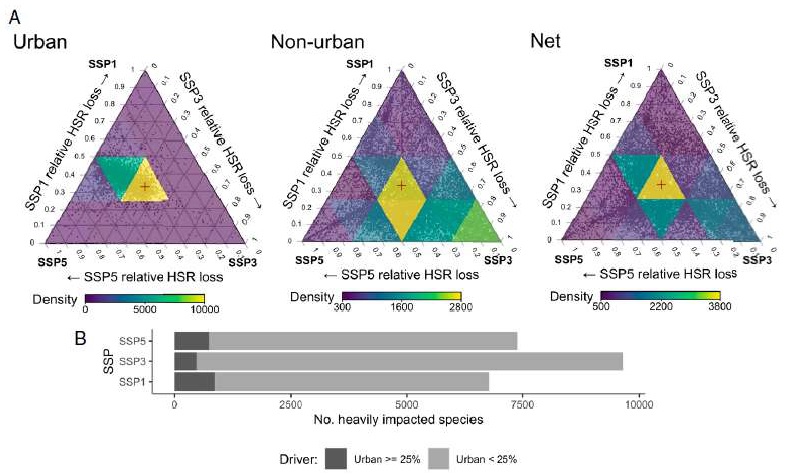Global Regions, Biological Diversity, and Urban Land to Significance
DOI:
https://doi.org/10.54741/asejar.2.2.1Keywords:
biodiversity, land, species loss, urbanization, priorities, habitat loss, global areasAbstract
As the world's urban population is expected to grow by 2.5 billion over the next 30 years, urban land conversions are likely to become a bigger cause of habitat and species loss. It is vital to gain a better understanding of the potential locations and mechanisms for these biodiversity losses in order to mitigate their impacts. In this study, we assess the projected habitat loss due to urban land expansion for 30,393 species of terrestrial vertebrates from 2015 to 2050 across three shared socioeconomic pathway (SSP) scenarios using a recently developed suite of land-use projections. We discover that for about one-third (26–39%) of the species evaluated, urban land expansion is a contributing driver of habitat loss (5% of total loss). Urban land is a direct cause of species imperilment for up to 855 species (2–3% of those assessed), accounting for at least 25% of a net habitat loss of 10% or more. Sub-Saharan Africa, South America, Mesoamerica, and Southeast Asia are the major developing tropical regions where urban clusters are most likely to threaten species owing to anticipated expansion. Our findings imply that methods for reducing the effects of urban land could improve international agreements for the preservation of biodiversity. To mitigate the effects predicted by our analysis, cooperative, global action that prioritises vulnerable species and regions may constitute an effective tactic.
Downloads
References
H. Gibb, & D. F. Hochuli. (2002). Habitat fragmentation in an urban environment: Large and small fragments support different arthropod assemblages. Biol. Conserv., 106, 91–100.
M. L. McKinney. (2006). Urbanization as a major cause of biotic homogenization. Biol. Conserv., 127, 247–260.
R. I. Mcdonald, P. Kareiva, & R. T. T. Forman. (2008). The implications of current and future urbanization for global protected areas and biodiversity conservation. Biol. Conserv., 141, 1695–1703.
Harrison, P. A. (2010). Ecosystem services and biodiversity conservation: an introduction to the RUBICODE project. Biodivers. Conserv, 19, 2767–2772.
W. Jetz, J.M.McPherson, & R. P. Guralnick. (2012). Integrating biodiversity distribution knowledge: Toward a global map of life. Trends Ecol. Evol., 27, 151–159.
K. C. Seto et al. (2012). Urban land teleconnections and sustainability. Proc. Natl. Acad. Sci. U.S.A., 109, 7687–7692.
J. Beninde, M. Veith, & A. Hochkirch. (2015). Biodiversity in cities needs space: A meta-analysis of factors determining intra-urban biodiversity variation. Ecol. Lett., 18, 581–592.
M. C. Urban et al. (2016). Improving the forecast for biodiversity under climate change. Science, 353, aad8466.
B. C. O’Neill et al. (2017). The roads ahead: Narratives for shared socioeconomic pathways describing world futures in the 21st century. Glob. Environ. Change, 42, 169–180.
J. van Vliet. (2019). Direct and indirect loss of natural area from urban expansion. Nat. Sustain., 2, 755–763.
Jung, M. et al. (2021). Areas of global importance for conserving terrestrial biodiversity, carbon and water. Nat. Ecol. Evol., 5, 1499–1509.
GLOBIO, Data from “Available GLOBIO4 scenario data.” GLOBIO. www.globio.info/globio-data-downloads. Accessed 2 March 2022.

Published
How to Cite
Issue
Section
ARK
License
Copyright (c) 2023 Dr. Alka Vyas, Dr. Rakhi Dwivedi

This work is licensed under a Creative Commons Attribution 4.0 International License.
Research Articles in 'Applied Science and Engineering Journal for Advanced Research' are Open Access articles published under the Creative Commons CC BY License Creative Commons Attribution 4.0 International License http://creativecommons.org/licenses/by/4.0/. This license allows you to share – copy and redistribute the material in any medium or format. Adapt – remix, transform, and build upon the material for any purpose, even commercially.










